NAVY VETERAN ROBERT “JOHN” DOWEY FAREWELLED AFTER A LIFE WELL LIVED… JUST DON’T SERVE HIM CANNED HERRING!
By LEUT Daren K Cherian RAN
Many young kids these days finish high school and then party hard with a big blowout known these days as Schoolies. Following their revelry, a few even take a year off, either travelling or broadening their horizons with other experiences before starting their life of responsibility as adults. But for one young kid, there was no drunken carousing nor was there a “gap year”. This young lad attained his School Leaving Certificate at age sixteen and had immediately been accepted by the Glebe Branch of the Commonwealth Bank of Australia. Schoolies, being a frivolity conceived by the more comfortable modern generations, was not something he could avail himself of; instead, he was marched around by his mother to prospective employers before securing his situation.
The year was 1939 and that young enterprising fellow was Robert Dowey. So who was he and why is it important for us to remember him?
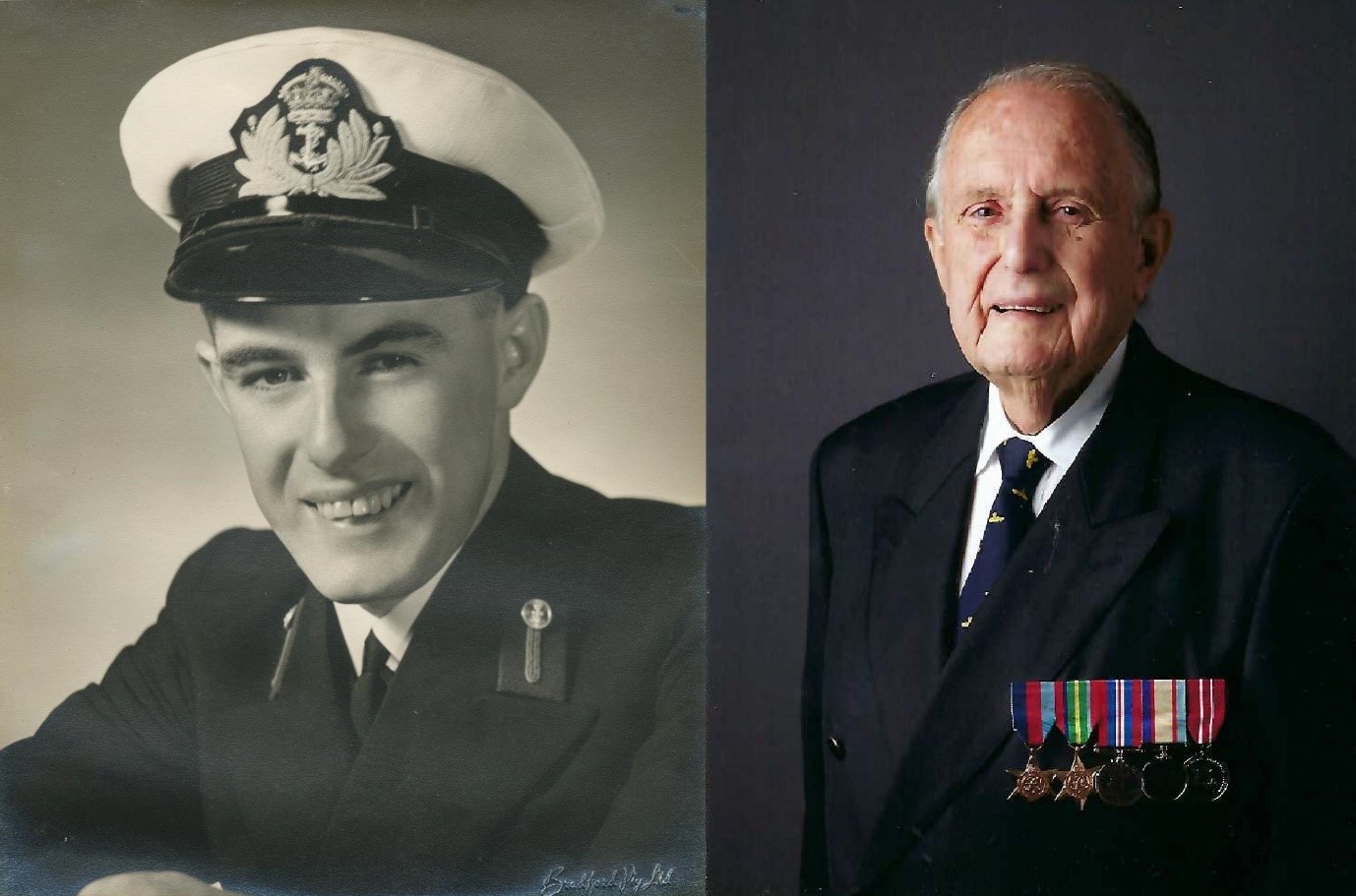
As Australia, and the world in general, continues to plod forward into the 21st century dealing with crises such as raging bush-fires, devastating floods, the COVID pandemic, Kabul’s fall to the Taliban and the Russo-Ukraine conflict, it has been almost 77 years since the Empire of Japan signed the Instrument of Surrender in Tokyo Bay aboard the USS Missouri. And these days the ranks of those heroes who won us the war are slowly dwindling.
One such hero was Robert “John” Dowey, RAN who, on 15 March 2022, was laid to rest in a solemn service at the St. James Anglican Church at Turramurra, NSW with friends and family present. A modest contingent of Navy personnel attended the service to pay respects to a veteran who had served during WWII.
Robert Dowey, or “John” as he was better known as by all his friends, may not have had an exceptionally long career in the defence force, but he sure served during the critical period that affected not only Australia but the entire world.
His initial employment at the bank was nothing fancy and as a Junior Clerk it even involved him completing menial tasks like emptying out waste baskets. But Dowey had been recognised as a competent and intelligent young lad willing to go the extra mile, and as his seniors were drafted into the armed services, Management was confident in Dowey’s capabilities enough to make him suffer through speedy promotions all the way up to Senior Ledger Clerk.
Then at age 18, on 30 December 1941, John was drafted into the Australian Army. He spent over seven months in khakis training as a Gunner while posted to the 12 Army Field Regiment. John’s preference was always the water, and losing his front teeth from tripping over a tent peg in the dark while undergoing his training may have also darkened his perspective of Army life.
John Dowey was at the Leppington camp the very night that Sydney Harbour came under attack from the Japanese midget submarines in May 1942, although at the time, neither he nor his colleagues knew exactly what the commotion was about. Residents assumed the loud noises that shook their houses and broke windows were a result of training exercises and newspaper reports of the attack two days later caused quite a tizzy amongst John and his mates.
Interestingly enough, roughly seventy-two years later, on his 91st birthday when John Dowey visited the site of his Army training camp at Leppington, it still existed in its natural state devoid of man’s touch despite Sydney’s land grab for property development.
John Dowey’s transfer to the RAN came through on 24 August 1942. He enlisted as an Ordinary Seaman, but soon got the call to commission and graduated as a Midshipman. Clearly he was recognised for his leadership potential and fast tracked to an officer career.
On 17 September 1943, after training at HMAS Rushcutter’s Fairmile Training School, MIDN Dowey, age 19, changed bases to HMAS Melville in Darwin where he embarked on ML814, a newly commissioned Fairmile class Motor Launch as one of the three officers. To put this into context, at age 19, John Dowey was well aware that he was still technically a child, unable to go into a licensed premises or make a will. He would never let his family forget that he learned to navigate a warship even before he was licenced to drive a car.
“It was in Darwin and I remember joining it on a night in late September 1943 at 8 PM when the tide was out. And I had my first experience of climbing down and down the ladder at main wharf jetty to get to it because it was a seven or eight metre tide,”. (AWM interview)
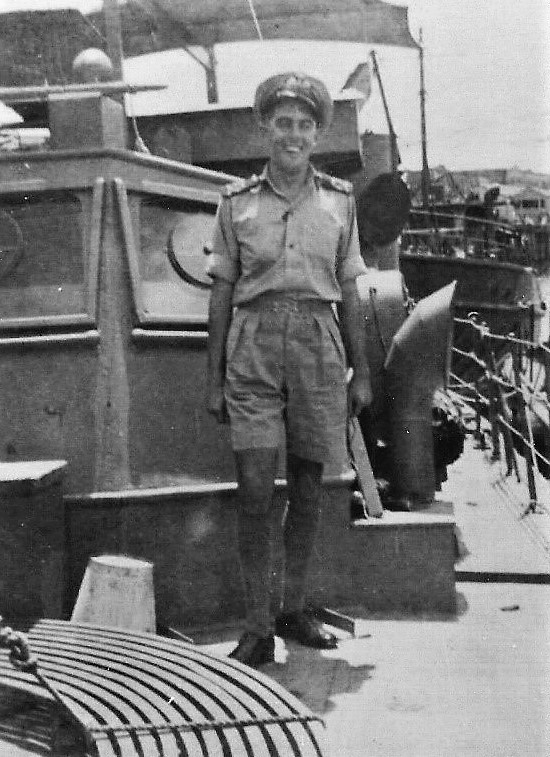
Dowey’s responsibilities included keeping watches and general duties. With a crew of only 17, everyone on board multi-tasked. Virtually everyone had a gun station. His crew was fortunate enough to have had a sailor who was not only a good cook but was willing to do it on a permanent basis, sparing the others from this duty.
If you had tried to offer John Dowey herrings in tomato sauce you probably would have received a scowl in return, and for good reason. With space on board limited, tinned food was tucked away in the bilges. With the wartime rations, the crew had the handsome variety of three types of tinned goods; namely, herrings in tomato sauce, bully beef and vegetables or baked beans. Unfortunately, due to leaking bilges, on one occasion the labels of all tins disintegrated into a soggy mess and pick of the day was a pot luck draw. Much to the frustration of the cook and the rest of the crew, their luck was always “herrings in tomato sauce”.
Another role held by Dowey was similar to a task undertaken by Maritime Logistics Branch officers and sailors today. Smoking was as popular back then as it is today, albeit a lot more acceptable and John was in charge of the issue of cigarettes and tobacco rations to the smokers amongst his crew.
ML 814 tanks held 2,200 gallons of high octane petrol, and if the vessel came under enemy attack, fire would have been the greatest danger. Come October, the wet season exacerbated living conditions inside the ship with rising steam following the heavy rain each day. Mildew throughout the vessel formed the perfect breeding ground for roaches and bugs which then contributed to tropical infections. Following the hospitalisation of LEUT Marsden Hordern due to a medical condition, John Dowey was appointed as ML814’s First Lieutenant in January 1944. Hordern, a lifelong friend of Dowey, turned 100 in March 2022.
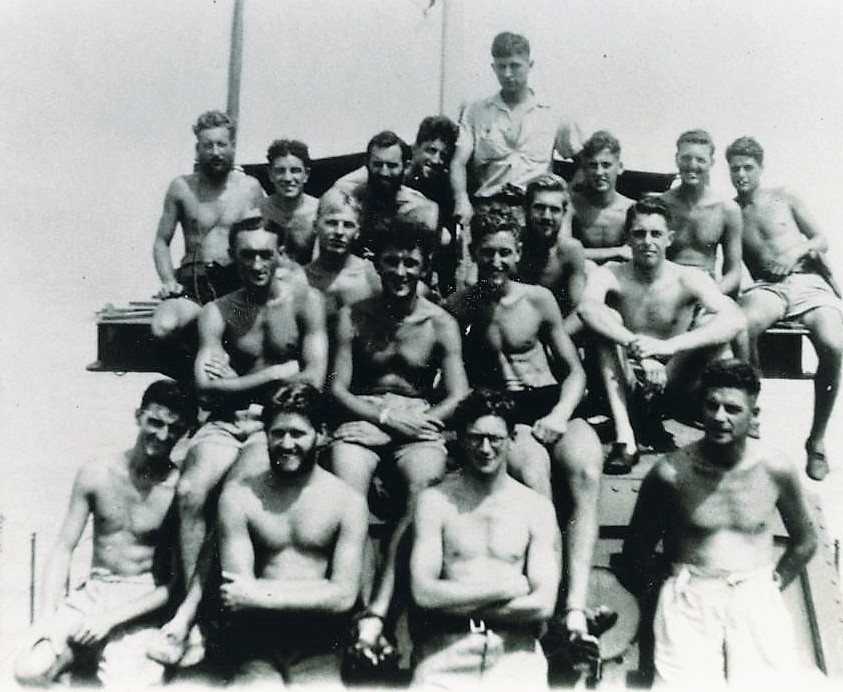
Robert John Dowey and Crew of ML 814. Seated second row, far right.
Of the many missions that ML814 was given, such as harbour defence and escort duties, one of the more significant ones was Operation Bulldozer (commenced 27 January 1944), the naval aspect of a much larger strategy known as Operation Cobra under the Services Reconnaissance Department (SRD). Dowey’s ship had been given the task of landing Australian commandos and Timorese soldiers behind enemy lines into Japanese occupied Timor. The ship travelled alone, with the RAAF providing air cover. Extremely rough weather and poor visibility initially hampered their passage while the crew struggled with sea sickness. At the rendezvous, the ship’s flashing light challenges were ignored. The crew expected to be greeted by Australian SRD members who had been landed ashore by previous operations. SBLT Dowey was ordered to take the SRD Cobra members and a landing party ashore to investigate. After being met by local Timorese and being assured that everything was in order, the SRD members set about their assigned task while SBLT Dowey and his landing party returned back to ML814. Unfortunately, the original landing parties had been captured and compromised, and due to this, unknown to the boat crew, the newly landed SRD Cobra members were soon captured by the Japanese. ML814 returned safely back by 31 January. SBLT Dowey was one of two members who had been singled out for special mention in the post operation report by the Commanding Officer. Incidentally, John Dowey developed and maintained a close association throughout his life with Sergeant A.J. “Jim” Ellwood, who had been one of the operatives captured by the Japanese having spent 2 years as a POW and subject to torture. Ellwood passed away in December 2021 within a fortnight of his 100th birthday.
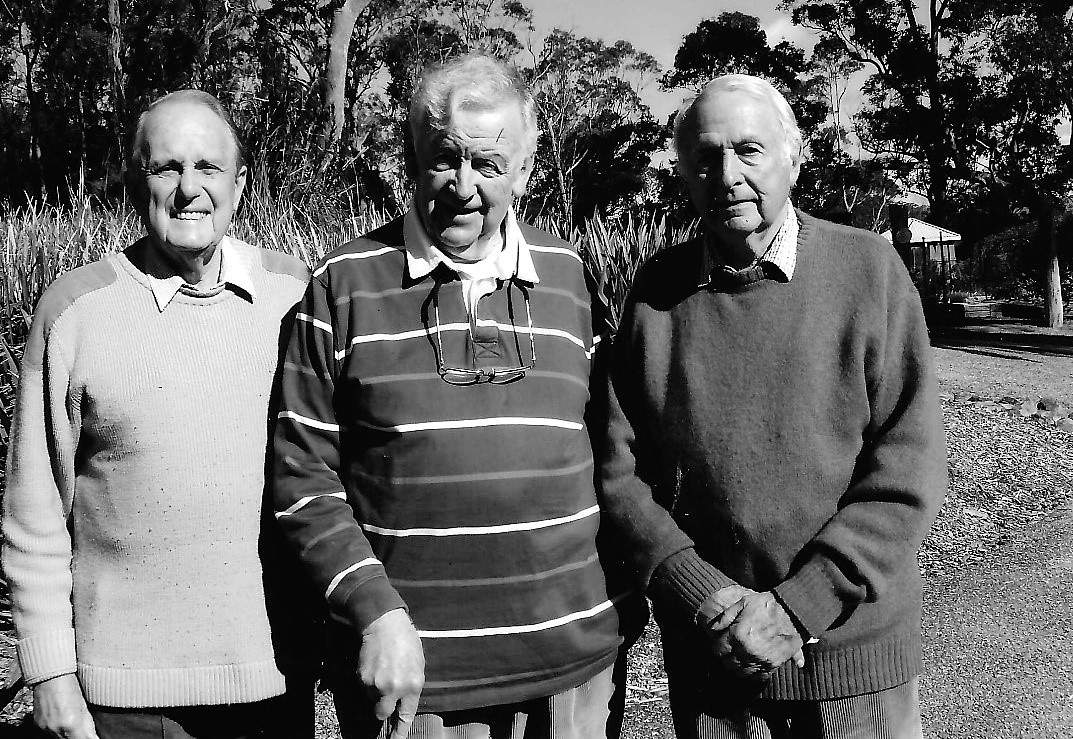
John Dowey, Jim Elwood and Marsden Hordern
An event that stood in the crew’s mind and held the young Dowey in good stead was “The Great Landing Barge Incident.” While ML814 was alongside Darwin, an Army member who had previously been taken to task for a sloppy mooring of his landing craft, decided to act against the crew after having imbibed a whole lot of liquid courage. While on watch, Dowey investigated a great thumping to the side of his ship. It was a dark night, but it soon became apparent that a landing craft was t-boning the side of the ship. Sizing the situation quickly, Dowey jumped aboard the craft, fought for and gained control of the vessel after knocking out the drunken soldier. Due to the huge tidal swell the barge was being swept down the harbour, but after establishing how to steer the vessel, he navigated it back to the wharf. Unsure of how the melee had played out on board the craft, and under the velvet cover of nightfall, the crew mistook Dowey for the drunk and apprehension levels rocketed as someone yelled out, “Look out…here he comes again!” Of course they soon realised that Dowey was in full control.
SBLT Dowey’s range of experience also covered the Fairmile sister ships ML815, ML826 and ML807. Dowey had acting command of ML807, when their CO was granted leave for the birth of his son. He was on ML814 in Darwin during the final Japanese air raid in November 1943. Of all the Fairmiles, ML815 was the only one that sailed from the east coast, around the north and down to the west. He was of course part of their crew when the ship sailed from Darwin to Fremantle for a refit.
On the day of the Japanese surrender, their ship was halfway across the Gulf of Carpentaria when the naval HQ had just sent a signal for them to “cease all warlike operations”. But at the time, for the crew warlike operation were the furthest thing from their mind as they were busy dealing with a galley fire.
SBLT Dowey saw out the war and retired from the RAN on 20 February 1946. John Dowey stayed on within the RANVR as a LEUT and retired in 1966.
John Dowey credited the Navy service with instilling in him the finer points of leadership and responsibility along with his crack navigational skills.
He put his navigational skills to good use when he secured the role of the navigator on board Mistral II; a 64 foot stay-sail schooner with a Bermudan mainsail; which participated in the 1949 and 1950 Sydney to Hobart yacht races.

John Dowey reads the log with assistance of Bill Williams during a Sydney to Hobart Yacht Race on Mistral II
Dowey earned the 1939-1945 Star and the Pacific Star, both given for operational service during the period as well as the War Medal 1939-1945 which includes operation and non-operation service during the period. In addition he was awarded the Australia Service Medal 1939-45 and the Australian Defence Medal.
Robert “John” Dowey’s accomplishments did not stop there. He returned to the Commonwealth Bank completing several university degrees, all done at night while maintaining his full-time day job. By 1954 he had a Bachelor of Economics and a Bachelor of Law under his belt, both awarded from the University of Sydney. The next year when he was transferred to the London Office of the bank, he commenced his Master of Laws at the London School of Economics, University of London, again attending evening lectures and earning his Masters in 1957.
John Dowey continued his stellar career with the bank, staying with the Reserve Bank when it separated from the Commonwealth Bank in 1960. He stayed with the Reserve Bank until his retirement with some of his posts being the Secretary of the Reserve Bank of Australia between 1974-1980 and the bank’s Chief Representative in Europe (based in London) from 1980-1983.
John Dowey married, had two sons and three grandchildren. When dealing with two young boys behaving rather unruly in the house, he often thought back to his time on ML815 being refitted in Fremantle when the USS Griffin and USS Euryale were in close proximity and about how impressed he was with the American ship’s loudspeaker which would loudly inform its crew starting with the words, “Now hear this!” It is fondly believed he wished for a similar system for his household at such times.
In true Navy lingo, John would always remind his family the importance of planning for any activity by uttering one of his favourite phrases, “Get your charts out! Get your charts out before you start your journey!”
He stayed active within the naval community through the Fairmile Association until it was discontinued in 2013. He and his fellow associates presented memorial plaques at various Australian ports where the ships were either built or based during WWII. He also marched every ANZAC day until 2013aged 89 years old.
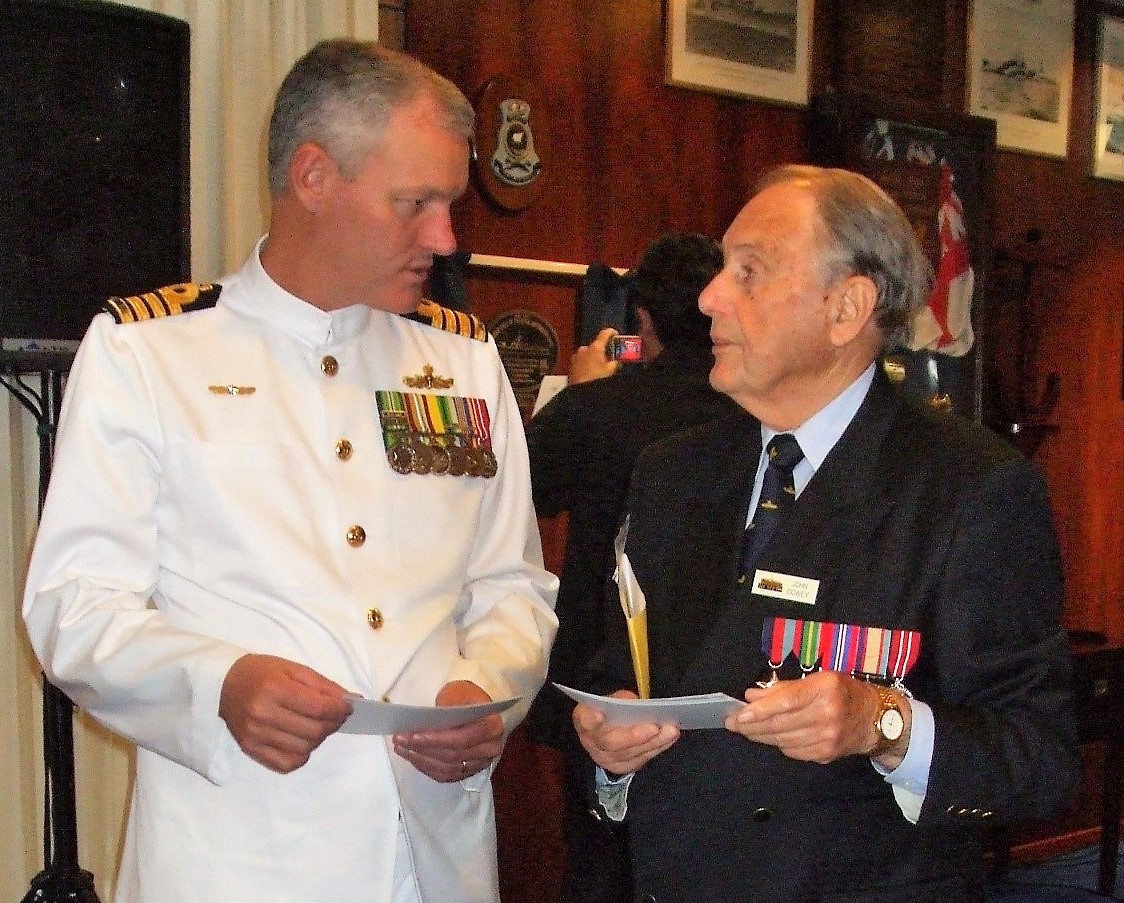
John Dowey with Captain Brett Wolski RAN




